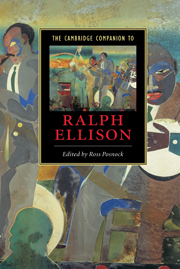Book contents
- Frontmatter
- Introduction
- 1 Ralph Ellison’s invented life
- 2 Ellison and the black Church
- 3 Ellison, photography, and the origins of invisibility
- 4 Ralph Ellison’s music lessons
- 5 Ralph Ellison’s constitutional faith
- 6 Ralph Ellison and the politics of melancholia
- 7 Invisible Ellison
- 8 Ellison’s experimental attitude and the technologies of illumination
- 9 Female iconography in Invisible Man
- 10 Chaos not quite controlled
- 11 Ralph Ellison, Hannah Arendt, and the meaning of politics
- 12 Dry bones
- Selected bibliography and suggestions for further reading
- Index
- Series List
7 - Invisible Ellison
the fight to be a Negro leader
Published online by Cambridge University Press: 28 May 2006
- Frontmatter
- Introduction
- 1 Ralph Ellison’s invented life
- 2 Ellison and the black Church
- 3 Ellison, photography, and the origins of invisibility
- 4 Ralph Ellison’s music lessons
- 5 Ralph Ellison’s constitutional faith
- 6 Ralph Ellison and the politics of melancholia
- 7 Invisible Ellison
- 8 Ellison’s experimental attitude and the technologies of illumination
- 9 Female iconography in Invisible Man
- 10 Chaos not quite controlled
- 11 Ralph Ellison, Hannah Arendt, and the meaning of politics
- 12 Dry bones
- Selected bibliography and suggestions for further reading
- Index
- Series List
Summary
In his moving story, ''Boy on a Train,'' written approximately fifteen years before the publication of Invisible Man (1952), Ellison portrays through the eyes of an eleven-year-old child the conflict that was to consume him both as an artist and as a cultural critic until his death in 1994: How to represent the distinctiveness of Negro American culture without being consumed by the soul-killing racism endemic to American life. James, the protagonist of the story, is riding with his mother and brother in a Jim Crow train car away from their home in Oklahoma City to begin a new life after the death of James's father. The reader sees the boy first as his mother directs his attention to the fall colors of the passing trees and tells him that Jack Frost ''made the leaves pretty'' and that he ''paints the leaves all the pretty colors.'' This moment of innocence between mother and child contrasts sharply with the anger James witnesses from his mother when ''a butcher had tried to touch her breasts'' (Flying, 13). Her response is defiant: ''she had spat in his face and told him to keep his dirty hands where they belonged'' (13-14). Traveling in the JimCrow car, seeing that the hostile treatment his family receives is in part a consequence of others’ perception of their skin color, the boy begins to understand his place in a racially divisive society.
- Type
- Chapter
- Information
- The Cambridge Companion to Ralph Ellison , pp. 137 - 156Publisher: Cambridge University PressPrint publication year: 2005

